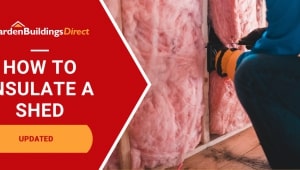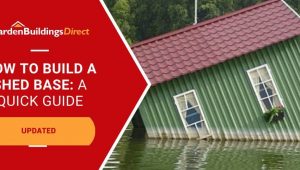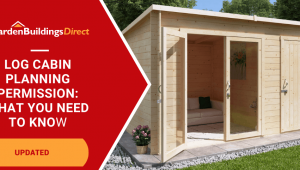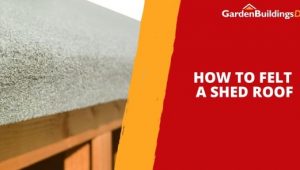Jump to:
Trying to fix a wooden shed roof that’s started to bow or dip in the middle?
Sagging can happen for a few reasons, but it’s not a fault with the structure itself. In most cases, it can be corrected. Let’s go over the steps to fix this issue, shall we?
How to Check and Fix a Sagging Wooden Shed Roof
Find the cause and fix the issue before it gets worse, using these five steps:
1. Check for signs of sloping down
Look for dips on the ridge line, gaps between the panels, or “shifted” sections. These signs often point to strain on the roof frame. They’re often due to movement in the timber or insufficient internal support.
2. Inspect the internal roof structure
Head inside and have a look at the purlins, a.k.a. the horizontal timber beams running across, if they’re:
- Fixed to the frame
- Straight, not bending or twisting
- Evenly spaced with no big gaps in between
If the shed is new, make sure the purlins haven’t been put in the wrong way round.
3. Adjust the purlin orientation
The purlins need to be positioned with their deeper edge standing upright, not laid flat. For instance, if they measure 44mm x 70mm, the 70mm side must face up vertically. Installed the other way round, they won’t hold the weight as they should, and the roof can sag over time.
To correct this:
- Unscrew and rotate the purlins
- Reattach them at each end
A flat-fitted purlin won’t hold the load, and that’s what leads to sagging.
4. Add support in weak spots
This is often the case when the span between purlins is too wide, say more than 1.2m to 1.5m. You can:
- Add another purlin between the existing ones
- Fit a vertical brace under the centre for extra support
- Use angle brackets or timber connectors to strengthen joins and stop movement
5. Replace damaged parts
Cracked, warped, or softened purlins won’t hold up, so swap them out. Use pressure-treated timber for replacements. Take out the damaged piece, cut a new one to size, and screw it back onto the frame where it connects on each side.
If you’re browsing for new purlin timber, consider C16 or C24 graded softwood. These are noted for their loadbearing capability.
Don’t try to patch over weak timber, as it will only give away again sooner or later.
Why Do Shed Roofs Sag?
It’s often caused by one or more of the following:
Incorrect installation
Purlins are laid flat instead of upright, spaced too far apart, or not fixed on each side. This weakens the support and and that’s when it starts to dip.
Poor maintenance
Leaves, debris, and pooled water are putting extra weight on the roof. The added strain weakens and puts pressure on the frame, especially after heavy rain or snow.
Timber movement
The timber has shifted due to changes in moisture and temperature. Joints are no longer aligned, fixings have loosened, and some boards have started to warp.
Bonus: Simple habits to prevent roof bowing
- Mind the spacing and keep purlins no more than 1.2 to 1.5m apart. Wide gaps need extra support.
- Clear off debris and sweep off leaves, moss, and pooled water before they add weight.
- Check after storms to see if there’s any loose fixings or timber that’s moved out of place.
These steps on how to fix shed roof sagging should help you get on top of the issue. Spot what’s off, take your time with the support, and replace what’s past saving. You’ll have it sorted before it turns into something bigger.
If your current shed is beyond repair or you’re planning a sturdier upgrade, explore our full range of wooden sheds built for durability and year-round protection.
This guide might also help: Should You Use Nails or Screws on a Wooden Shed?





